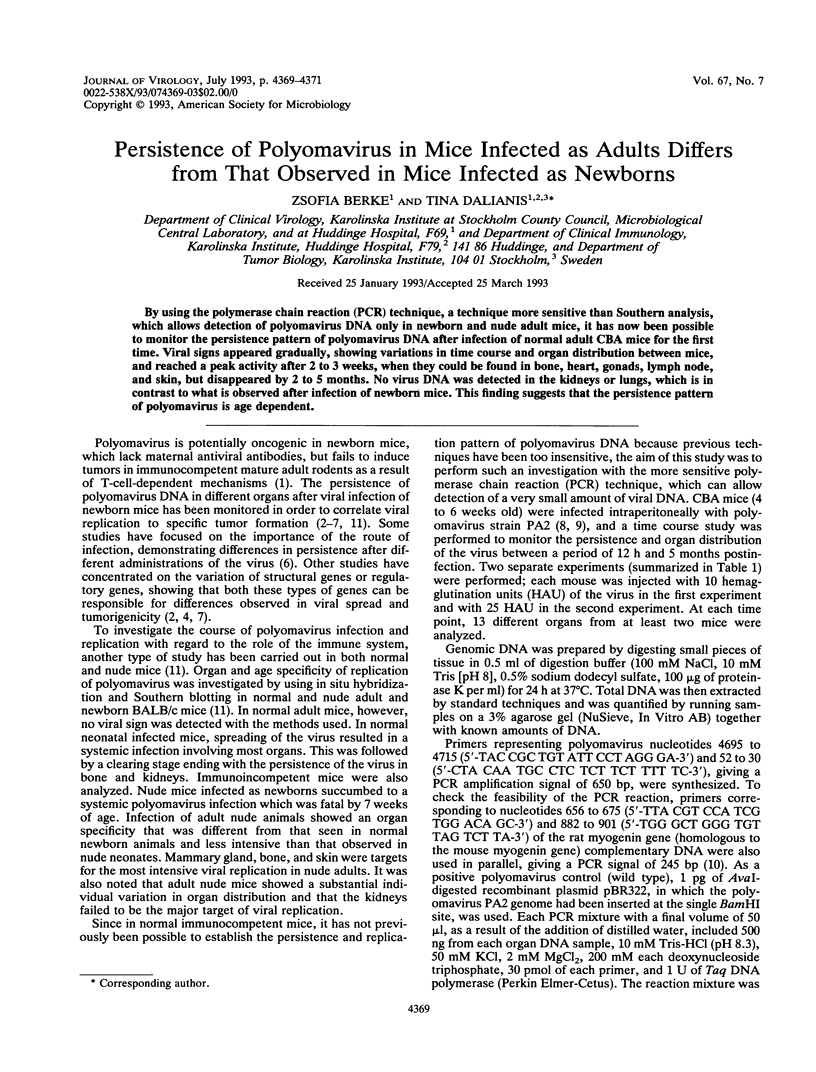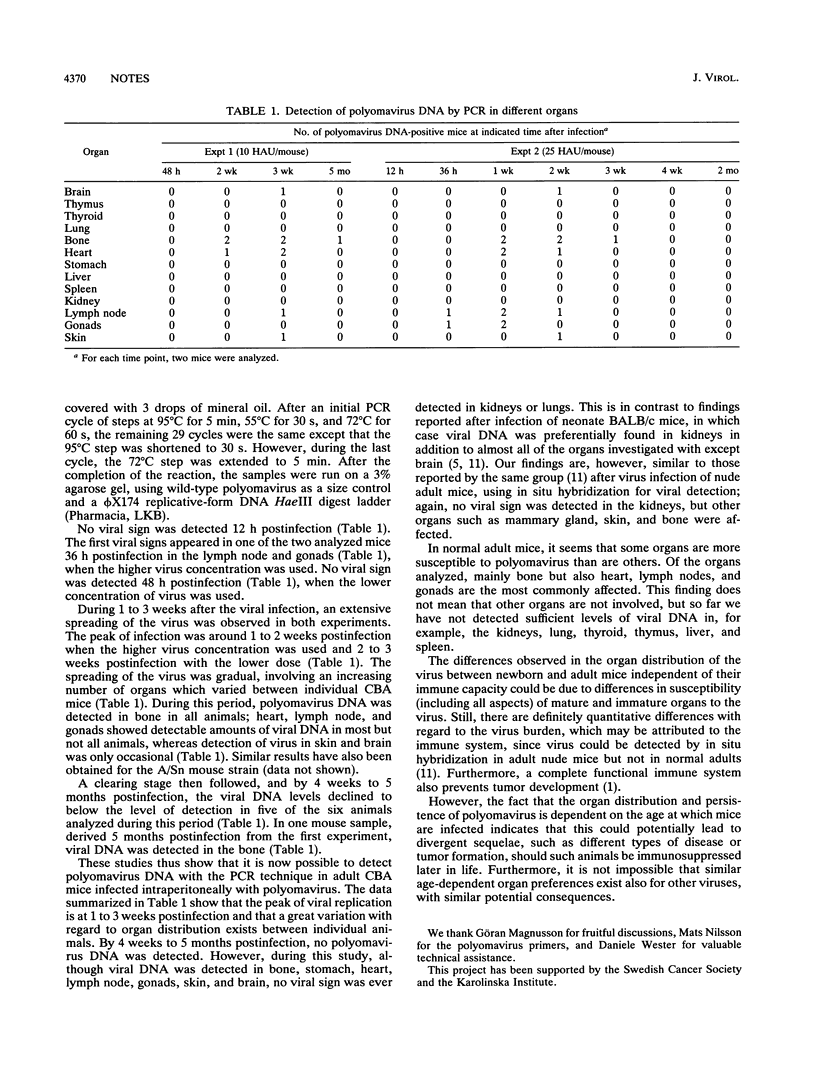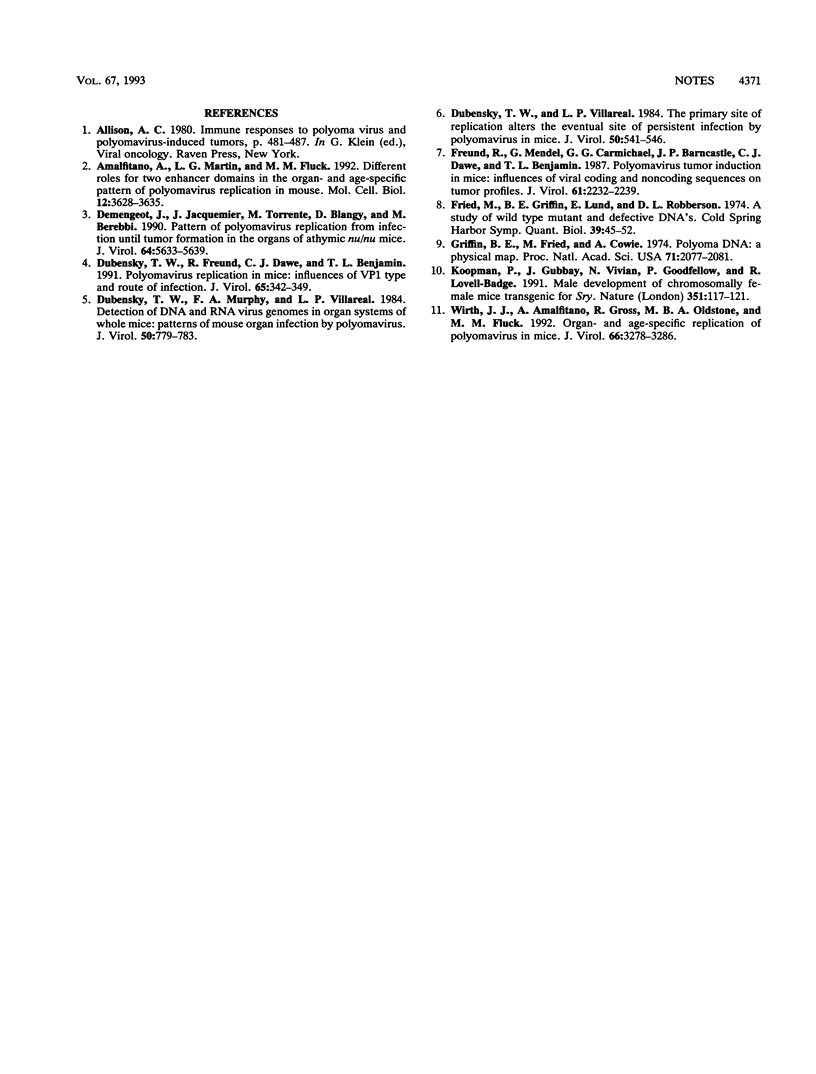Abstract
By using the polymerase chain reaction (PCR) technique, a technique more sensitive than Southern analysis, which allows detection of polyomavirus DNA only in newborn and nude adult mice, it has now been possible to monitor the persistence pattern of polyomavirus DNA after infection of normal adult CBA mice for the first time. Viral signs appeared gradually, showing variations in time course and organ distribution between mice, and reached a peak activity after 2 to 3 weeks, when they could be found in bone, heart, gonads, lymph node, and skin, but disappeared by 2 to 5 months. No virus DNA was detected in the kidneys or lungs, which is in contrast to what is observed after infection of newborn mice. This finding suggests that the persistence pattern of polyomavirus is age dependent.
Full text
PDF


Selected References
These references are in PubMed. This may not be the complete list of references from this article.
- Amalfitano A., Martin L. G., Fluck M. M. Different roles for two enhancer domains in the organ- and age-specific pattern of polyomavirus replication in the mouse. Mol Cell Biol. 1992 Aug;12(8):3628–3635. doi: 10.1128/mcb.12.8.3628. [DOI] [PMC free article] [PubMed] [Google Scholar]
- Demengeot J., Jacquemier J., Torrente M., Blangy D., Berebbi M. Pattern of polyomavirus replication from infection until tumor formation in the organs of athymic nu/nu mice. J Virol. 1990 Nov;64(11):5633–5639. doi: 10.1128/jvi.64.11.5633-5639.1990. [DOI] [PMC free article] [PubMed] [Google Scholar]
- Dubensky T. W., Freund R., Dawe C. J., Benjamin T. L. Polyomavirus replication in mice: influences of VP1 type and route of inoculation. J Virol. 1991 Jan;65(1):342–349. doi: 10.1128/jvi.65.1.342-349.1991. [DOI] [PMC free article] [PubMed] [Google Scholar]
- Dubensky T. W., Murphy F. A., Villarreal L. P. Detection of DNA and RNA virus genomes in organ systems of whole mice: patterns of mouse organ infection by polyomavirus. J Virol. 1984 Jun;50(3):779–783. doi: 10.1128/jvi.50.3.779-783.1984. [DOI] [PMC free article] [PubMed] [Google Scholar]
- Dubensky T. W., Villarreal L. P. The primary site of replication alters the eventual site of persistent infection by polyomavirus in mice. J Virol. 1984 May;50(2):541–546. doi: 10.1128/jvi.50.2.541-546.1984. [DOI] [PMC free article] [PubMed] [Google Scholar]
- Freund R., Mandel G., Carmichael G. G., Barncastle J. P., Dawe C. J., Benjamin T. L. Polyomavirus tumor induction in mice: influences of viral coding and noncoding sequences on tumor profiles. J Virol. 1987 Jul;61(7):2232–2239. doi: 10.1128/jvi.61.7.2232-2239.1987. [DOI] [PMC free article] [PubMed] [Google Scholar]
- Fried M., Griffin B. E., Lund E., Robberson D. L. Polyoma virus--a study of wild-type, mutant and defective DNAs. Cold Spring Harb Symp Quant Biol. 1975;39(Pt 1):45–52. doi: 10.1101/sqb.1974.039.01.009. [DOI] [PubMed] [Google Scholar]
- Griffin B. E., Fried M., Cowie A. Polyoma DNA: a physical map. Proc Natl Acad Sci U S A. 1974 May;71(5):2077–2081. doi: 10.1073/pnas.71.5.2077. [DOI] [PMC free article] [PubMed] [Google Scholar]
- Koopman P., Gubbay J., Vivian N., Goodfellow P., Lovell-Badge R. Male development of chromosomally female mice transgenic for Sry. Nature. 1991 May 9;351(6322):117–121. doi: 10.1038/351117a0. [DOI] [PubMed] [Google Scholar]
- Wirth J. J., Amalfitano A., Gross R., Oldstone M. B., Fluck M. M. Organ- and age-specific replication of polyomavirus in mice. J Virol. 1992 Jun;66(6):3278–3286. doi: 10.1128/jvi.66.6.3278-3286.1992. [DOI] [PMC free article] [PubMed] [Google Scholar]


